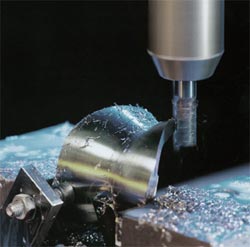High-speed Manufacturing of Medical Implants

The challenge with artificial knee, shoulder, or hip joints lies in the fact that the materials, such as titanium or chromium cobalt, are very difficult to machine, but the complex shapes must be produced very precisely in order to provide an optimal fit for the patient.
The increased longevity of people and their desire to remain active is driving increased demand for implants. In Germany, 200,000 joint and hip replacements are already being performed each year. To ensure that the implants are as durable and long-lasting as possible, increasingly harder materials are being used to make them.
This not only increases the cost; it also poses greater challenges in terms of the implant manufacturing process. With a new milling technology and the high-speed cutting process from Siemens Industry Automation and Drive Technologies, implants can be made not only with ultimate precision; they can also be manufactured in less time and thus more cost effectively.
An optimally fitted implant begins with photos of the joint that is to be replaced. The images are taken with a computer tomography or magnetic resonance imaging scanner. The doctor uses these pictures to virtually choose a suitable implant on the computer and positions it, with the help of 3D planning software, at the location of the joint to be replaced. A further Siemens planning tool, the CAD/CAM software NX CAM, simulates the production of the joint in a test run to avoid later damage to the expense titanium or chromium cobalt workpieces and to achieve an optimal precision fit. The traversing paths identified in the simulation are forwarded to the machine tools, which then use a metal-cutting process to produce these precision-fitted implants. The machines work with a spindle speed of 40,000 to 60,000 revolutions per minute.
The technology can also be used to manufacture dental implants, an application where fast, precision manufacturing of implants saves time and money for doctors and patients alike. The challenge is in the mass production of custom workpieces, which is actually an oxymoron. High-productivity dental manufacturing is only possible with an optimally coordinated process chain, from imaging of the patient’s condition to the production of the implant.
Media Contact
More Information:
http://www.siemens.com/innovationnewsAll latest news from the category: Machine Engineering
Machine engineering is one of Germany’s key industries. The importance of this segment has led to the creation of new university degree programs in fields such as production and logistics, process engineering, vehicle/automotive engineering, production engineering and aerospace engineering among others.
innovations-report offers informative reports and articles covering technologies such as automation, motion, power train, energy, conveyor, plastics, lightweight construction, logistics/warehousing, measurement systems, machine tools and control engineering.
Newest articles

Innovative 3D printed scaffolds offer new hope for bone healing
Researchers at the Institute for Bioengineering of Catalonia have developed novel 3D printed PLA-CaP scaffolds that promote blood vessel formation, ensuring better healing and regeneration of bone tissue. Bone is…

The surprising role of gut infection in Alzheimer’s disease
ASU- and Banner Alzheimer’s Institute-led study implicates link between a common virus and the disease, which travels from the gut to the brain and may be a target for antiviral…

Molecular gardening: New enzymes discovered for protein modification pruning
How deubiquitinases USP53 and USP54 cleave long polyubiquitin chains and how the former is linked to liver disease in children. Deubiquitinases (DUBs) are enzymes used by cells to trim protein…



